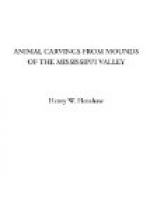If it be found that there are good reasons for pronouncing the carvings not to be accurate copies from nature, and of a lower artistic standard than has been supposed, it will remain for the archaeologist to determine how far their unlikeness to the animals they have been supposed to represent can be attributed to shortcomings naturally pertaining to barbaric art. If he choose to assume that they were really intended as imitations, although in many particulars unlike the animals he wishes to believe them to represent, and that they are as close copies as can be expected from sculptors not possessed of skill adequate to carry out their rude conceptions, he will practically have abandoned the position taken by many prominent archaeologists with respect to the mound sculptors’ skill, and will be forced to accord them a position on the plane of art not superior to the one occupied by the North American Indians. If it should prove that but a small minority of the carvings can be specifically identified, owing to inaccuracies and to their general resemblance, he may indeed go even further and conclude that they form a very unsafe basis for deductions that owe their very existence to assumed accurate imitation.
MANATEE.
In 1848 Squier and Davis published their great work on the Mounds of the Mississippi Valley. The skill and zeal with which these gentlemen prosecuted their researches in the field, and the ability and fidelity which mark the presentation of their results to the public are sufficiently attested by the fact that this volume has proved alike the mine from which subsequent writers have drawn their most important facts, and the chief inspiration for the vast amount of work in the same direction since undertaken.
On pages 251 and 252 of the above-mentioned work appear figures of an animal which is there called “Lamantin, Manitus, or Sea Cow,” concerning which animal it is stated that “seven sculptured representations have been taken from the mounds.” When first discovered, the authors continue, “it was supposed they were monstrous creations of fancy; but subsequent investigations and comparison have shown that they are faithful representations of one of the most singular animal productions of the world.”
These authors appear to have been the first to note the supposed likeness of certain of the sculptured forms found in the mounds to animals living in remote regions. That they were not slow to perceive the ethnological interest and value of the discovery is shown by the fact that it was immediately adduced by them as affording a clew to the possible origin of the Mound-Builders. The importance they attached to the discovery and their interpretation of its significance will be apparent from the following quotation (p. 242):




